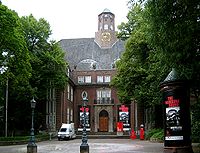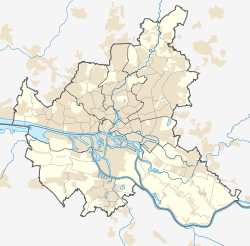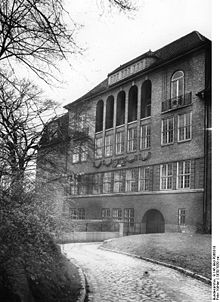- hamburgmuseum
-
Coordinates: 53°33′04″N 9°58′23″E / 53.551111°N 9.973056°E
hamburgmuseum
Museum für Hamburgische Geschichte (German)
Entrance of the museum.Established 1839 / 1922 Location Hamburg, Germany Type History museum Website www.hamburgmuseum.de (English) The hamburgmuseum (or hm), also known as Museum für Hamburgische Geschichte ("Museum for Hamburg History"), is a history museum located in the city of Hamburg in northern Germany. The museum was established at its current location in 1922, although its parent organization was started in 1839. The museum was named hamburgmuseum in 2006. It is located near the Planten un Blomen park in the center of Hamburg.
Contents
History
The main building was designed by Fritz Schumacher and constructed between 1914 and 1922.
The museum courtyard was damaged from the great fire in 1842 and fully restored in 1995. A glass dome over the inner courtyard was completed in 1989.
The Hamburg Observatory occupied the area at the Museum from 1825 to 1912 before being moved to Bergedorf. The area was part of the old city wall, part of Bastion Henricus, a baroque fortification built between 1616 and 1625.[1] The museum was formerly located at the Johanneum school.
The museum became state-owned under the direction of Otto Lauffe, though this was changed back in 1999.
The museum adopted the name hamburgmuseum, and initials hm, in 2006. In 2008 the museum runs a program called hm freunde (Society of friends of the museum of Hamburg history).[2]
Interior and contents
The museum has many artifacts from preserved by the Society of Hamburg History founded in 1839. The Petri portal from Hamburg's St. Petri Church, built in 1604, was built into the museum courtyard.
- Exhibits in 2005
- Kleidung und Mode: Kostüme und Kleidung in Hamburg von 1550–1920
- Hamburgisches Mäzenatentum: Familie Lorenz-Meyer als Beispiel
- Musik und Kunst in Hamburg
- Theater und Wissenschaft in Hamburg
- Hamburg im 20. Jahrhundert
- Der Hamburger Börsenvorplatz von 1558
- Hamme, Burg und Hansestadt – Hamburg im Mittelalter
- Kirchen, Kanonen und Kommerz – Hamburg in der frühen Neuzeit
- Reformation in Hamburg
- Hamburg als Währungszentrum
- Das Schiffswrack von Wittenbergen
- Bauen und Wohnen und die Sicherung der Elbe vor Piraten
- Barocke Kaufmannsdiele
- Stadtbild und Verfassung im 17. Jahrhundert
- Hamburg 1650-1860
- Die HafenCity – Hamburg im 21. Jahrhundert
- Kommandobrücke des Dampfers WERNER
- Zur Wohnkultur
- Geschichte der Juden in Hamburg [3]
- Klopstockzimmer
- Barocke Wohnräume
- Kunsthandwerk und Wohnkultur
- 1945. Kriegsende in Hamburg
Visitors
The museum takes part in the Long Night of Museums of Hamburg.[4]
See also
References
- ^ http://www.hamburgmuseum.de/e/htm_e/textversion/t-museum.html
- ^ http://www.hamburgmuseum.de/e/htm_e/neu/information-verein.html
- ^ Pelc, Ortwin. Jews In Hamburg. (trans. Guido G. Möring). University of Hamburg. http://www.rrz.uni-hamburg.de/rz3a035/hamhismus.html. Retrieved 2009-08-29.
- ^ "Lange Nacht der Museen Museum für Hamburgische Geschichte" (in German). Der Museumsdienst Hamburg. http://www.langenachtdermuseen-hamburg.de/die+museen/museum+fuer+hamburgische+geschichte.htm. Retrieved 2009-08-29.
Further reading
- Horbas, Claudia; Pelc, Ortwin (2002) (in German). Es brannte an allen Ecken und Enden zugleich – Hamburg 1842 Zur Ausstellung im Museum für Hamburgische Geschichte, Nov. 2002 bis Febr. 2003. Heide: Boyens. ISBN 9783804211148.
External links
Categories:- Museums established in 1922
- Museums in Hamburg
- Local museums in Germany
- City museums
- History of Hamburg
- 1922 establishments in Germany
- German museum stubs
- Hamburg building and structure stubs
Wikimedia Foundation. 2010.


